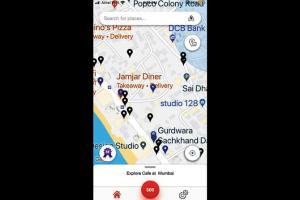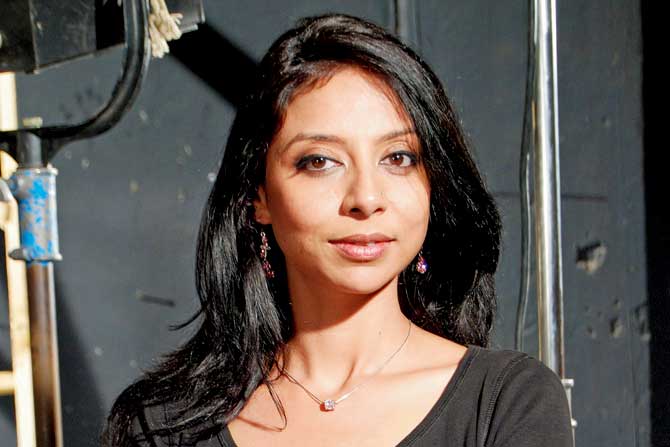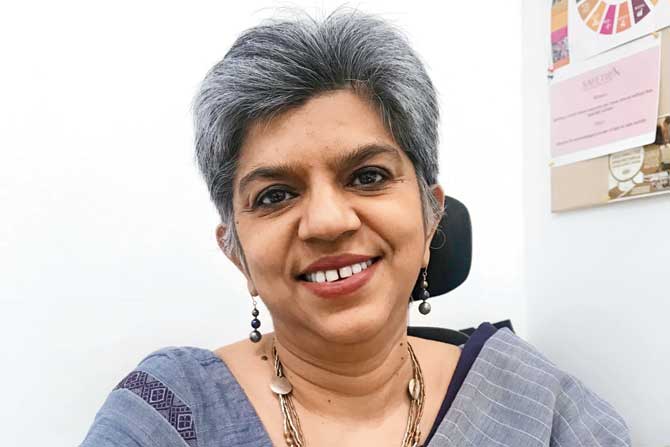Founders of two safety-rating apps, old and new, come together to discuss how a city can be made safe, and what role technology can play

Colour-coded markings of establishments indicate the level of safety on Phree For Safety. While blue is safe, red indicates unsafe
The last time this writer connected with independent filmmaker Madhureeta Anand was in 2017 when she had launched a non-fiction webseries titled Know Your Porn, to bring to light issues surrounding pornography. It’s not about being anti-porn or wanting to ban pornography, she had said, but to help people negotiate the legalities of what they are consuming, so that they are able to shun unlawful material.
Three years later, Anand has trained her attention to safety in public spaces. Violence and harassment against women and girls in public spaces, she believes, remains largely neglected, with few laws or policies in place to address it. Phree For Safety is her safety-rating application to engage citizens and use their contributions to make cities safer.
ADVERTISEMENT

Madhureeta Anand
But Anand isn’t the first to use technology to begin the discourse on safety. In 2013, a year after the Delhi bus gangrape, researcher and gender rights activist Dr Kalpana Viswanath co-founded SafetiPin. The location-based, crowd-sourced mobile app collects safety-related information from users and posts it for the benefit of others. The goal is to provide data to help city planners, law enforcers and campaigners to see problem areas. Viswanath has worked as a consultant with UN Women and UN-Habitat on issues of gender and urban safety and spearheaded the Safe Delhi for Women initiative led by Jagori in Delhi.
In a joint interview for Sunday mid-day, they discuss the role of technology in creating freedom of movement, and innovative approaches to make cities safe
and sustainable.

Kalpana Viswanath
Edited excerpts from the interview.
What makes a space safe? Are there parametres?
KV: Globally, many cities have conducted safety audits, so we collected enough data and zeroed in on a few parameters, which were common to all the different checklists. For instance, is it a walkable city, and conversely if you build a city for walkability, then it is also a safe city. The most important parameter is visibility. This means if you’re standing on a street, can you be seen? Is there a balcony or a shop or cafe or tea stall, which gives you eyes on the streets? Mumbai has good eyes on the streets. But in Delhi, it’s lacking. So even if there are CCTV cameras in every corner, I still wouldn’t walk there at night. What we want users to express is their feeling about a place because other data about lighting, infrastructure can be sought using images. Feelings are important.
MA: Safety is both personal and dynamic. Therefore, the parameters of safety are highly variable. For example, in one location, bad elements hanging around makes it unsafe. In another it could be thefts. In a third, it could be sexual abuse. The review section of the app provides a way for this individuality to be expressed. We will be able to see what constitutes safety in which location and for whom. And since we are a real time app, this can change rapidly and it will be reflected as well.
So an incident could spark a boost in ratings and reviews, creating a hotspot.
Mumbai is considered one of the safest cities in India. What makes it better than other metros?
MA: It is, but let’s not forget what we are comparing it with. Basically, sexual assault is so common in some other cities that we actually consider the lack of it to be safe. Actually, safety means not just in one’s own area but everywhere, and at all times. Having said that, Mumbai is safer because the law enforcement agency means business, and, is therefore, feared. The mindset of the people here is open, non-aggressive, less feudal. Presently, the feedback we are getting is that certain areas are primarily unsafe because bad elements claim these streets after a certain time. For instance, the Shakti Mills compound area is perceived as highly unsafe. After the rape, there have been reports of women avoiding the area. The Vile Parle and Bandra-Kurla stretches are also seen as unsafe. There have been reports of burglaries and rape in this area.
KV: Every city has pockets that are safe and not-so-safe. That said, as a woman, I’d be much more comfortable stepping out at midnight in Mumbai than Delhi. That’s because the city has good lighting. But the more important factor is that the streets are full of people and that’s a big factor for us as urban safety activists. You have much more life on the streets. It’s a cultural difference. Even Ahmedabad is safe in that respect. So, streets where people walk, eat and shop are more accessible.

Viswanath says the emphasis is on collecting data about what users feel about a particular place
What do you think is wrong with the way our cities are designed?
KV: They are not always designed for inclusion or to be easy for everybody to use. They are not neutral spaces and have often been planned and designed keeping in the mind the ‘male worker citizen. Which reflects in the kinds of infrastructure, exclusions, lack of opportunities, thus impacting access for marginalised groups like women or transgenders. So we need to make cities walkable, create more parks, better transport and increase last mile connectivity. I feel Safetipin played a part in getting the conversation going.
MA: The truth is safety is a by-product of social conditioning. For example, we have been told that several areas in a city like Paris are considered highly unsafe. Even in Los Angeles and in an area like Santa Monica, one is told not to go to certain areas after sunset. Safety is highly influenced by social factors like status of women, economic disparity and effective law enforcement. While we can try and light areas better or improve other civic facilities, nothing will change unless people do. We will need to get more people from vulnerable groups to come out into spaces. You know how people often say “I know it’s a safe area because I have seen women there”. Well, it’s true.
How can technology help?
KV: You can build an emergency app button, but how many of us have actually used it? If I had a second, I would call 100. It’s not just about creating an application, it’s about using technology as an enabler to bring about social change. The safety information and analytics that we collect are provided to stakeholders such as the police and civic authorities. The goal is to influence policies and find ways to make a city more equitable. For example, 7,400 poorly-lit public areas in the city of Delhi were identified using the open data generated through our app, and later many were improved by the city government.
MA: The idea is to work at several levels. Firstly, just about anyone can access the app to see how safe or unsafe an area is, thereby giving them a pre-emptive tool for safety. Secondly, law enforcement will have access to the app where they will not only be able to keep track of what areas/streets/establishments are being marked safe or unsafe but will also have access to why it is considered so. This will act as pressure on them to rectify the problem. Lastly, we will publish and share information and statistics about safety globally to help tailor policies. In essence, we hope to shift the onus of safety from vulnerable groups to society [where it belongs].
Keep scrolling to read more news
Catch up on all the latest Mumbai news, crime news, current affairs, and a complete guide from food to things to do and events across Mumbai. Also download the new mid-day Android and iOS apps to get latest updates.
Mid-Day is now on Telegram. Click here to join our channel (@middayinfomedialtd) and stay updated with the latest news
 Subscribe today by clicking the link and stay updated with the latest news!" Click here!
Subscribe today by clicking the link and stay updated with the latest news!" Click here!







